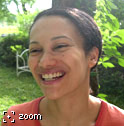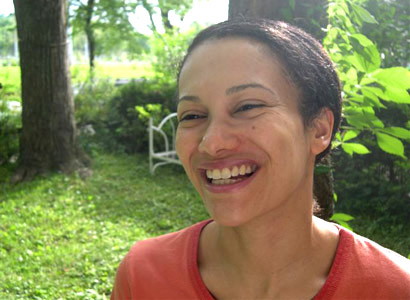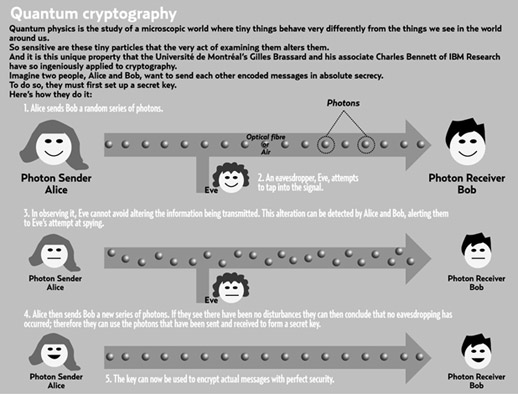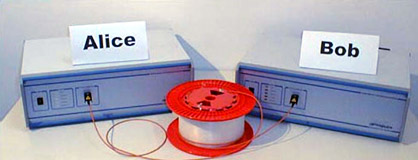By Alison MacGregor
 It began 25 years ago in the warm coastal waters of Puerto Rico when a stranger swam over to Gilles Brassard and struck up a conversation about using quantum physics to make bank notes impossible to counterfeit.
It began 25 years ago in the warm coastal waters of Puerto Rico when a stranger swam over to Gilles Brassard and struck up a conversation about using quantum physics to make bank notes impossible to counterfeit.
“I
had no idea who he was,” recalled Brassard, then a 24-year-old prodigy
and computer-science professor at the Université de Montréal. “He just
started talking nonsense about quantum physics.”
The
stranger turned out to be U.S. physicist Charles H. Bennett. Their
chance meeting while attending a theoretical computer science
conference would end up revolutionizing the art of code making, also
known as cryptography. Together, Brassard and Bennett would go on to
found a field of science—quantum information processing—whose effects
on society some say could even rival the impact that the steam engine
had in its time.
Already, experts agree, Brassard and Bennett’s most famous invention, a technique known as quantum cryptography,
is set to eliminate terrifying vulnerabilities that could soon arise in
the way governments, banks, the military, business and the public use
computers and the Internet to communicate and store data.
Some
observers see the technology as one day making the Internet secure
enough that medical professionals could share confidential health data
online in ways that would be insecure now.
Yet for all its promise, this invention is also making governments nervous.
The
ability to send unbreakable coded messages could just as easily be
exploited, authorities fear, by criminals and terrorists who now lack a
foolproof way of avoiding having their messages cracked.
In
the midst of all this excitement and controversy is Montreal-based
Brassard, who has made Canada a world leader in his fast-growing field.
Because of him, Canada “has turned out to be the best
place in the world” to do research in quantum information processing,
says physicist Raymond Laflamme, a leading figure in the field who
recently returned to Canada from a post with the U.S. Department of
Energy’s Los Alamos National Laboratory.
“All of this is thanks to Gilles,” he says.
Barry
Sanders, a quantum physicist who recently returned to Canada from a
research post in Australia, agrees, saying Brassard has played a key
role in making this country “the world leader in this field.”
Brassard
and Bennett’s invention sprung from their discovery of how principles
from the previously unlinked fields of quantum physics and computer
science could be combined to establish an unbreakable secret key.
Instead
of transmitting information along cables via electronic signals, they
use polarized photons—tiny particles of light—that are so sensitive
that when intercepted, they immediately become corrupted. This renders
the message unintelligible and tips off both sender and intended
recipient to the spying attempt.
What’s causing particular
excitement now is that the way that applications of Brassard and
Bennett’s technology have just been commercialized and put to market.
Since
late 2003, consumers have been able to acquire quantum cryptographic
systems that make short-haul computer links unbreakable to spies. The
systems are being sold by two competitors in Geneva and New York for as
little as $70,000 U.S. Both firms’ devices use Brassard and Bennett’s
seminal insight.
But that’s only a start, Laflamme says. “The potential is absolutely enormous.”
Intrigued
during their chance encounter off the shores of Puerto Rico by the idea
of impossible-to-forge bank notes, the two men repaired to
air-conditioned restaurants and cafes where they tossed it around some
more.
They left the island firm friends, returning,
respectively, to Montreal and Croton-on-Hudson, a village just north of
New York City, where they continued their brainstorming.
While
the anti-counterfeiting idea ultimately proved impractical, both
scientists soon realized that one of its underlying principles—a theory
that exploited the unique properties of photons—could be applied more
broadly to code making.
Cryptography has always been a race between code-makers and code-breakers.
Today’s
most sophisticated codes, used for the protection of information on
computers, rely on hugely complex mathematical calculations that
present-day computers aren’t believed to be powerful enough to solve.
Yet
as Brassard explains, it’s possible someone has already figured out how
to crack these codes. If so, such a person might want to keep this
quiet so as to benefit personally, Brassard remarked, although there
could also be an altruistic reason for doing so.
The reason?
“Society
would collapse, electronic commerce would collapse,” Brassard says.
“There would be chaos. I would keep quiet—just as I would if I found a
new weapon of mass destruction.”
But the biggest fear in
the cryptographic world is that a new kind of super-powerful “quantum
computer” could soon be constructed that would have the capacity to
quickly solve the kinds of code-breaking problems that today’s
computers are stumped by.
Already, experts say, a U.S.
mathematician, Peter Shor, has developed a formula that could be used
by a quantum computer, once one has been built, to crack current
encryption technology.
The prospect of such a computer
being constructed obviously worries governments, business and the
military—and should be of concern to all who value their privacy.
It
would be “a nuclear bomb to the Internet,” says Barry Sanders, director
of the University of Calgary’s Institute for Quantum Information
Science. “All of the security that we rely on when we use the Internet
would be obsolete.”
And this is why Brassard and Bennett’s
invention is causing such a stir: theirs is the first practical form of
cryptography that could not be broken, even by some yet-to-be-built
quantum computer.
The key to the security of a quantum
cryptography code, Laflamme explains, is that it “does not involve
solving a mathematical problem; it would involve breaking the laws of
physics.”
Brassard and Bennett’s collaboration has led to
another breakthrough, too. In an invention reminiscent of Star Trek,
the two physicists and their colleagues have developed a “quantum
teleportation” technology that can dissemble a particle of matter in
one location and beam it for reassembly in another.
This
technique was invented in 1992, first tested experimentally four years
later with photons and is still being tested by scientists around the
world.
(One of the co-inventers of the technique was
Brassard’s former student Claude Crépeau, who now directs his own
research team in quantum information processing at McGill University.)
In
1999, the invention inspired a best-selling novel—Timeline, by Michael
Crichton—and a spinoff Hollywood movie of the same name.
Filmed
in Montreal and released two years ago, the storyline features
protagonists being quantum-teleported back to the Middle Ages.
Brassard
and Bennett’s inventions have also generated enormous attention from
the world science media. An October 1992 cover story in Scientific
American magazine gave the duo’s quantum cryptography technique its
first burst of stardom.
Now, a second wave of coverage has
come as experiments prove the commercial viability of their
cryptography technique and fledgling new products make their way to
market.
Most recently, Brassard and Bennett’s cryptography
technique was again the subject of a cover story—this time in the
January issue of Scientific American. They’ve also drawn coverage from
Britain’s New Scientist and as well as in German, Australian and
Japanese media outlets, among others.
Yet the technology
still faces serious distance limitations. Photons can only travel so
far before they fade. They require amplification at regular intervals
if they’re to be transmitted over long distances—something that has not
yet proved feasible. Scientists are working hard to overcome this
limitation.
So far, the record for transmitting coded
messages through fibre-optic cables is 100 kilometres; the maximum
distance reached to date through the air is 23 kilometres between two
mountaintops.
This latter achievement is of particular
significance because it’s generally considered harder to transmit
photons through the thicker air found near the Earth’s surface than up
toward space, where there’s less atmospheric interference.
That’s
why scientists are hopeful they’ll soon be able to send photons to
satellites, which typically orbit 150 kilometres above the Earth. Such
a development would set the stage for the launch of the world’s first
truly global unbreakable encrypted communications system.
So
promising is the field of quantum information processing that
governments and corporations around the world are investing millions of
dollars in research in the field.
The first-ever local
quantum-encrypted network of computers is now up and running in
Cambridge, Mass., where it is managed by the pioneering Internet firm
BBN Technologies Inc.
And the Los Alamos National
Laboratory’s quantum cryptography team has joined with six European
research institutions to push the field further. In December, the team
tied with another group to snag one of the world’s most prestigious
science prizes—the European Union’s $1.3-million (U.S.) Descartes
research prize—for its project to build a secure global quantum
cryptographic communications system.
In Canada, Research
in Motion founder and co-chief executive Mike Lazaridis put up $100
million of his own money in 1999 to fund the non-profit and independent
Perimeter Institute of Theoretical Physics in Waterloo, now a leading
centre of quantum information research. (Two more RIM executives have
since contributed another $20 million, while Ottawa and Ontario have
kicked in another $54 million.)
Last month, the University of Calgary got into the act, launching its Institute for Quantum Information Science.
There have been commercial developments, too.
In
2003, a Swiss firm, id Quantique SA of Geneva, became the first to sell
a quantum cryptography system to the public. Another company, New York
City’s MagiQ Technologies Inc., soon followed.
Yet
Brassard and Bennett haven’t made a penny from these ventures; they’ve
chosen not to patent their discovery in the hopes of fostering an
environment where colleagues can feel unhindered in their efforts to
develop the field.
Other companies with projects in the
works include IBM—where Bennett is a research fellow at the company’s
Yorktown Heights, N.Y., research centre—and Japanese computing giants
NEC, Fujitsu and Toshiba.
So great is the interest among
potential buyers that industry analyst Martin Illsley predicts the
technology will be widespread in business and government settings in as
little as five years.
Early adopters will likely be
financial institutions, governments and telecommunications firms, said
Illsley, an associate partner at consulting firm Accenture Inc., in a
telephone interview from France.
Others share that
optimism. In a report, International Data Corp. has predicted the
market for quantum cryptography products will be about $30 million U.S.
within three years—and about $300 million within 10 years.
Brassard has gathered a devoted group of researchers and students at the Université de Montréal’s computer science department.
Now 49, he grew up in Ahuntsic, where his father was an accountant and his mother taught yoga.
He
credits his three older brothers—all scientists as well—with inspiring
him to pursue his precocious interest in math, a precursor to his
fascination with computers and physics.
A brilliant
student, Brassard had entered secondary school by age 10 and was
already doing his undergraduate studies at the Université de Montréal
by age 13.
At the time, he recalls, he thought there was
“nothing unusual” about attending university so young. He said other
students treated him well “even though I looked rather small and young
for my age.”
Now living in Outremont with his two daughters, Brassard says he reads, cooks and listens to classical music in his spare time.
He
used to play squash and go cross-country skiing too. But these days, he
says wistfully, there’s no time for that. All the attention swirling
about him—and the fast pace of developments in his field—keeps Gilles
Brassard a very busy man.
Further Readings
Bennett, C. H., Brassard, G. and Ekert, A. K., Quantum cryptography, Scientific American, October 1992, pp. 50-57.
Stix, G., Best-Kept Secrets, Scientific American, January 2005, pp. 78-83.
Singh, S., The Code Book: The Science of Secrecy from Ancient Egypt to Quantum Cryptography, Random House Inc., 1999.
Web Sites
Gilles Brassard
Charles Bennett
Claude Crépeau
Raymond Laflamme
Barry Sanders
Université de Montréal: Laboratoire d’Informatique Théorique et Quantique
McGill University: Crypto and Quantum info lab
Perimeter Institute of Theoretical Physics
University of Calgary’s Institute for Quantum Information Science
id Quantique SA
MagiQ Technologies Inc.
© The Gazette 2006. Republished with permission. Originally published February 2005.

















 InnovationCanada.ca was a winner in the Canadian Public Relations Society’s National Awards of Excellence
(Electronic & Interactive Communication category) in June 2006. The
Awards Program showcases Canada’s best public relations talent, and
offers a opportunity to be recognized for outstanding work in
communications.
InnovationCanada.ca was a winner in the Canadian Public Relations Society’s National Awards of Excellence
(Electronic & Interactive Communication category) in June 2006. The
Awards Program showcases Canada’s best public relations talent, and
offers a opportunity to be recognized for outstanding work in
communications.
